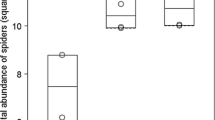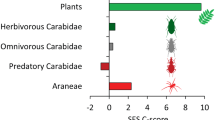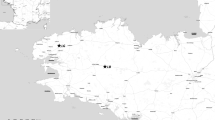Summary
The hypotheses that vegetation structural diversity and prey availability determine alpha diversity were examined for scrub- and meadow-inhabiting web spider species assemblages along elevational gradients in Costa Rica and California. Prey availabilities were estimated by sticky trap catches, using only the orders and size classes of insects actually captured by the spiders. The measured component of vegetation structural diversity was the maximum tip height in 20 cm increments from 0 to 2.0 m. Spider species diversity and vegetation tip height diversity were both expressed by the Inverse Simpson Index. Web spider species diversity is highly significantly correlated with vegetation tip height diversity. Prey availability is not a significant predictor of web spider species diversity in these habitats.
Similar content being viewed by others
References
Abraham BJ (1983) Spatial and temporal patterns in a sagebrush steppe spider community (Arachnida: Araneae). J Arachnol 11:31–50
Balling SS, Resh VH (1982) Arthropod community response to mosquito control recirculation ditches in San Francisco Bay salt marshes. Environ Entomol 11:801–808
Beaver DL, Baldwin PH (1975) Ecological overlap and the problem of competition and sympatry in the Western and Hammond's flycatchers. Condor 77:1–13
Bradley RA, Schumann DE (1957) The comparison of the sensitivities of similar experiments: applications. Biometrics 13:496–510
Brown KM (1981) Foraging ecology and niche partitioning in orbweaving spiders. Oecologia (Berlin) 50:380–385
Bultman TL, Uetz GW (1982) Abundance and community structure of forest floor spiders following litter manipulation. Oecologia (Berlin) 55:34–41
Buskirk RE, Buskirk WH (1976) Changes in arthropod abundance in a highland Costa Rican rain forest. Amer Midl Nat 95:288–298
Chaplin S (1976) Organization of the hemipteran and spider fauna associated with two cold desert shrubs. Ph.D. thesis, Cornell University, Ithaca
Cody ML (1968) On the methods of resource division in grassland birds. Amer Natur 102:104–147
Connell JH, Orias E (1964) The ecological regulation of species diversity. Amer Natur 98:399–413
Denne K (1982) Food or form: do spiders make a choice? Amer Arachnol 26:14-(Abstr)
Duffey E (1962) A population study of spiders in limestone grassland. Description of study area, sampling methods and population characteristics. J Anim Ecol 25:85–111
Eberhard WG (1975) The ‘inverted ladder’ orb web of Scoloderus sp and the intermediate orb of Eustala(?) sp. (Araneae: Araneidae). J Nat Hist 9:93–106
Enders F (1974) Vertical stratification in orb-web spiders (Araneidae: Araneae) and a consideration of other methods of coexistence. Ecol 55:317–328
Feinsinger P (1976) Organization of a tropical guild of nectarivorous birds. Ecol Monogr 46:257–291
Fischer AG (1980) Latitudinal variations in organic diversity. Evol 14:64–81
Greenstone MH (1978) The numerical response to prey availability of Pardosa ramulosa (McCook) (Araneae: Lycosidae) and its relationship to the role of spiders in the balance of nature. Symp Zool Soc Lond 43:183–193
Greenstone MH (1983) Site-specificity and site tenacity in a wolf spider: a scrological dietary analysis. Oecologia (Berl) 56:79–83
Greenstone MH, Bennett AF (1980) Foraging strategy and metabolic rate in spiders. Ecol 61:1255–1259
Hill MO (1973) Diversity and evenness: a unifying notation and its consequences. Ecol 54:427–432
Howland AM (1981) A flora of Valentine Eastern Sierra Reserve. Part I. Valentine Camp. Herbarium, University of California, Santa Barbara, California
Jaksić FM (1981) Use and abuse of the term “guild” in ecological studies. Oikos 397–400
Janetos AL (1981) Foraging tactics of two guilds of web-spinning spiders. Behav Ecol Sociobiol 10:19–27
Janzen DH (1973a) Sweep samples of tropical foliage insects: description of study sites, with data on species abundances and site distributions. Ecol 54:659–686
Janzen DH (1973b) Sweep samples of tropical foliage insects: effects of seasons, vegetation types, elevation, time of day, and insularity. Ecol 54:687–708
Lawton JH (1983) Plant architecture and the diversity of phytophagous insects. Ann Rev Entomol 28:23–39
LeSar CD, Unzicker JD (1978) Life history, habits, and prey preference of Tetragnatha laboriosa (Araneae: Tetragnathidae). Environ Entomol 7:879–884
Lubin YD (1978) Seasonal abundance and diversity of web-building spiders in relation to habitat structure on Barro Colorado Island, Panama. J Arachnol 6:31–51
Lubin YD, Eberhard WG, Montgomery GG (1978) Webs of Miagrammopes (Araneae: Uloboridae) in the neotropics. Psyche 85:1–23
MacArthur RH (1969) Patterns of communities in the tropics. Biol J Linn Soc 1:19–30
MacArthur RH (1972) Geographical ecology. Harper and Row, New York
MacArthur RH, MacArthur JW (1961) On bird species diversity. Ecol 42:594–598
MacArthur R, Recher H, Cody M (1966) On the relation between habitat selection and species diversity. Amer Natur 100:319–332
May RM (1975) Patterns of species abundance and diversity. In: Cody ML, Diamond JM (eds) Ecology and evolution of communities. Cambridge, Belknap Press
Meserve PL (1976) Food relationships of a rodent fauna in a California coastal sage scrub community. J Mammal 57:300–319
Munz PA (1970) A California flora. University of California Press, Berkeley
Murdoch WW, Evans FC, Peterson CH (1972) Diversity and patterns in plants and insects. Ecol 53:819–829
Nyffeler M, Benz G (1978) Prey selection by the web spiders Argiope bruennichi (Scop.), Araneus quadratus Cl., and Agelena labyrinthica (Cl.) on fallow land near Zurich, Switzerland. Rev Suisse Zool 85:747–757
Olive CW (1980) Foraging specializations in orb-weaving spiders. Ecol 61:1133–1144
Olive CW (1981) Co-adapted foraging traits in a guild of orb weaving spiders. Oecologia (Berlin) 49:88–91
Pianka ER (1966) Latitudinal gradients in species diversity: a review of concepts. Amer Natur 100:33–46
Pianka ER (1967) On lizard species diversity: North American flatland deserts. Ecol 48:333–351
Riechert SE, Tracy CR (1975) Thermal balance and prey availability: based for a model relating web-site characteristics to spider reproductive success. Ecol 56:265–284
Robinson JV (1981) The effect of architectural variation in habitat on a spider community: an experimental field study. Ecology 62:73–80
Rohlf FJ, Sokal RR (1969) Statistical tables. Freeman, San Francisco
Root RB (1967) The niche exploitation pattern of the bluegrey gnatcatcher. Ecol Monogr 37:317–350
Rosenzweig ML, Winakur J (1969) Population ecology of desert rodent communities: habitat and environmental complexity. Ecology 50:558–572
Rottman RJ, Capinera JL (1983) Effects of insect and cattle-induced perturbations on a shortgrass prairie arthropod community. J Kans Entomol Soc 56:241–252
Schaefer M (1978) Some experiments on the regulation of population density in the spider Floronia bucculenta (Araneida: Linyphiidae). Symp Zool Soc Lond 42:203–210
Sellers WD (1965) Physical climatology. University of Chicago Press, Chicago
Southwood TRE (1978) Ecological methods. Chapman and Hall, New York, 2nd Ed
Thompson SD (1980) Microhabitat utilization, foraging behavior, energetics, and community structure of heteromyid rodents. PhD thesis, Univ of California, Irvine
Uetz GW, Johnson AD, Schemske DW (1978) Web placement, web structure, and prey capture in orb-weaving spiders. Bull Brit Arachnol Soc 4:141–148
Whittaker RH (1965) Dominance and diversity in land plant communities. Science 147:250–260
Whittaker RH (1972) Evolution and measurement of species diversity. Taxon 21:213–251
Author information
Authors and Affiliations
Additional information
U.S. Department of Agriculture, Biological Control of Insects Research Laboratory, Agriculture Research Service, Columbia, MO 65205, USA
Rights and permissions
About this article
Cite this article
Greenstone, M.H. Determinants of web spider species diversity: Vegetation structural diversity vs. prey availability. Oecologia 62, 299–304 (1984). https://doi.org/10.1007/BF00384260
Received:
Issue Date:
DOI: https://doi.org/10.1007/BF00384260




